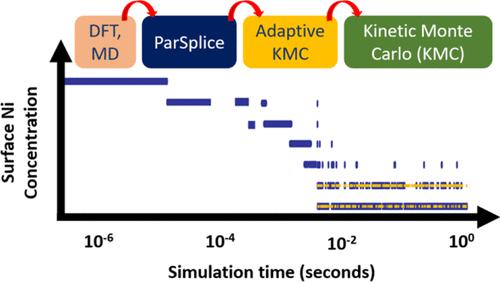当前位置:
X-MOL 学术
›
J. Chem. Theory Comput.
›
论文详情
Our official English website, www.x-mol.net, welcomes your
feedback! (Note: you will need to create a separate account there.)
Atomistic Mechanisms of Binary Alloy Surface Segregation from Nanoseconds to Seconds Using Accelerated Dynamics
Journal of Chemical Theory and Computation ( IF 5.7 ) Pub Date : 2022-06-07 , DOI: 10.1021/acs.jctc.2c00303 Richard B Garza 1, 2 , Jiyoung Lee 3, 4 , Mai H Nguyen 3 , Andrew Garmon 5, 6 , Danny Perez 5 , Meng Li 2 , Judith C Yang 2 , Graeme Henkelman 3, 4 , Wissam A Saidi 1
Journal of Chemical Theory and Computation ( IF 5.7 ) Pub Date : 2022-06-07 , DOI: 10.1021/acs.jctc.2c00303 Richard B Garza 1, 2 , Jiyoung Lee 3, 4 , Mai H Nguyen 3 , Andrew Garmon 5, 6 , Danny Perez 5 , Meng Li 2 , Judith C Yang 2 , Graeme Henkelman 3, 4 , Wissam A Saidi 1
Affiliation

|
Although the equilibrium composition of many alloy surfaces is well understood, the rate of transient surface segregation during annealing is not known, despite its crucial effect on alloy corrosion and catalytic reactions occurring on overlapping timescales. In this work, CuNi bimetallic alloys representing (100) surface facets are annealed in vacuum using atomistic simulations to observe the effect of vacancy diffusion on surface separation. We employ multi-timescale methods to sample the early transient, intermediate, and equilibrium states of slab surfaces during the separation process, including standard MD as well as three methods to perform atomistic, long-time dynamics: parallel trajectory splicing (ParSplice), adaptive kinetic Monte Carlo (AKMC), and kinetic Monte Carlo (KMC). From nanosecond (ns) to second timescales, our multiscale computational methodology can observe rare stochastic events not typically seen with standard MD, closing the gap between computational and experimental timescales for surface segregation. Rapid diffusion of a vacancy to the slab is resolved by all four methods in tens of nanoseconds. Stochastic re-entry of vacancies into the subsurface, however, is only seen on the microsecond timescale in the two KMC methods. Kinetic vacancy trapping on the surface and its effect on the segregation rate are discussed. The equilibrium composition profile of CuNi after segregation during annealing is estimated to occur on a timescale of seconds as determined by KMC, a result directly comparable to nanoscale experiments.
中文翻译:

使用加速动力学从纳秒到秒的二元合金表面偏析的原子机制
尽管许多合金表面的平衡成分已广为人知,但退火过程中瞬时表面偏析的速率尚不清楚,尽管它对合金腐蚀和在重叠时间尺度上发生的催化反应具有至关重要的影响。在这项工作中,代表(100)表面刻面的 CuNi 双金属合金使用原子模拟在真空中退火,以观察空位扩散对表面分离的影响。我们采用多时间尺度方法在分离过程中对板坯表面的早期瞬态、中间和平衡状态进行采样,包括标准 MD 以及执行原子、长时间动力学的三种方法:平行轨迹拼接 (ParSplice)、自适应动力学蒙特卡罗(AKMC)和动力学蒙特卡罗(KMC)。从纳秒 (ns) 到秒时间尺度,我们的多尺度计算方法可以观察到标准 MD 中通常看不到的罕见随机事件,缩小了表面偏析的计算时间尺度和实验时间尺度之间的差距。所有四种方法都可以在几十纳秒内解决空位向平板的快速扩散。然而,在两种 KMC 方法中,空位随机重新进入地下仅在微秒时间尺度上可见。讨论了表面动力学空位捕获及其对偏析率的影响。据估计,在退火过程中偏析后 CuNi 的平衡组成分布发生在由 KMC 确定的几秒钟的时间尺度上,这一结果与纳米级实验直接相当。缩小表面偏析的计算和实验时间尺度之间的差距。所有四种方法都可以在几十纳秒内解决空位向平板的快速扩散。然而,在两种 KMC 方法中,空位随机重新进入地下仅在微秒时间尺度上可见。讨论了表面动力学空位捕获及其对偏析率的影响。据估计,在退火过程中偏析后 CuNi 的平衡组成分布发生在由 KMC 确定的几秒钟的时间尺度上,这一结果与纳米级实验直接相当。缩小表面偏析的计算和实验时间尺度之间的差距。所有四种方法都可以在几十纳秒内解决空位向平板的快速扩散。然而,在两种 KMC 方法中,空位随机重新进入地下仅在微秒时间尺度上可见。讨论了表面动力学空位捕获及其对偏析率的影响。据估计,在退火过程中偏析后 CuNi 的平衡组成分布发生在由 KMC 确定的几秒钟的时间尺度上,这一结果与纳米级实验直接相当。仅在两种 KMC 方法中的微秒时间尺度上可见。讨论了表面动力学空位捕获及其对偏析率的影响。据估计,在退火过程中偏析后 CuNi 的平衡组成分布发生在由 KMC 确定的几秒钟的时间尺度上,这一结果与纳米级实验直接相当。仅在两种 KMC 方法中的微秒时间尺度上可见。讨论了表面动力学空位捕获及其对偏析率的影响。据估计,在退火过程中偏析后 CuNi 的平衡组成分布发生在由 KMC 确定的几秒钟的时间尺度上,这一结果与纳米级实验直接相当。
更新日期:2022-06-07
中文翻译:

使用加速动力学从纳秒到秒的二元合金表面偏析的原子机制
尽管许多合金表面的平衡成分已广为人知,但退火过程中瞬时表面偏析的速率尚不清楚,尽管它对合金腐蚀和在重叠时间尺度上发生的催化反应具有至关重要的影响。在这项工作中,代表(100)表面刻面的 CuNi 双金属合金使用原子模拟在真空中退火,以观察空位扩散对表面分离的影响。我们采用多时间尺度方法在分离过程中对板坯表面的早期瞬态、中间和平衡状态进行采样,包括标准 MD 以及执行原子、长时间动力学的三种方法:平行轨迹拼接 (ParSplice)、自适应动力学蒙特卡罗(AKMC)和动力学蒙特卡罗(KMC)。从纳秒 (ns) 到秒时间尺度,我们的多尺度计算方法可以观察到标准 MD 中通常看不到的罕见随机事件,缩小了表面偏析的计算时间尺度和实验时间尺度之间的差距。所有四种方法都可以在几十纳秒内解决空位向平板的快速扩散。然而,在两种 KMC 方法中,空位随机重新进入地下仅在微秒时间尺度上可见。讨论了表面动力学空位捕获及其对偏析率的影响。据估计,在退火过程中偏析后 CuNi 的平衡组成分布发生在由 KMC 确定的几秒钟的时间尺度上,这一结果与纳米级实验直接相当。缩小表面偏析的计算和实验时间尺度之间的差距。所有四种方法都可以在几十纳秒内解决空位向平板的快速扩散。然而,在两种 KMC 方法中,空位随机重新进入地下仅在微秒时间尺度上可见。讨论了表面动力学空位捕获及其对偏析率的影响。据估计,在退火过程中偏析后 CuNi 的平衡组成分布发生在由 KMC 确定的几秒钟的时间尺度上,这一结果与纳米级实验直接相当。缩小表面偏析的计算和实验时间尺度之间的差距。所有四种方法都可以在几十纳秒内解决空位向平板的快速扩散。然而,在两种 KMC 方法中,空位随机重新进入地下仅在微秒时间尺度上可见。讨论了表面动力学空位捕获及其对偏析率的影响。据估计,在退火过程中偏析后 CuNi 的平衡组成分布发生在由 KMC 确定的几秒钟的时间尺度上,这一结果与纳米级实验直接相当。仅在两种 KMC 方法中的微秒时间尺度上可见。讨论了表面动力学空位捕获及其对偏析率的影响。据估计,在退火过程中偏析后 CuNi 的平衡组成分布发生在由 KMC 确定的几秒钟的时间尺度上,这一结果与纳米级实验直接相当。仅在两种 KMC 方法中的微秒时间尺度上可见。讨论了表面动力学空位捕获及其对偏析率的影响。据估计,在退火过程中偏析后 CuNi 的平衡组成分布发生在由 KMC 确定的几秒钟的时间尺度上,这一结果与纳米级实验直接相当。











































 京公网安备 11010802027423号
京公网安备 11010802027423号